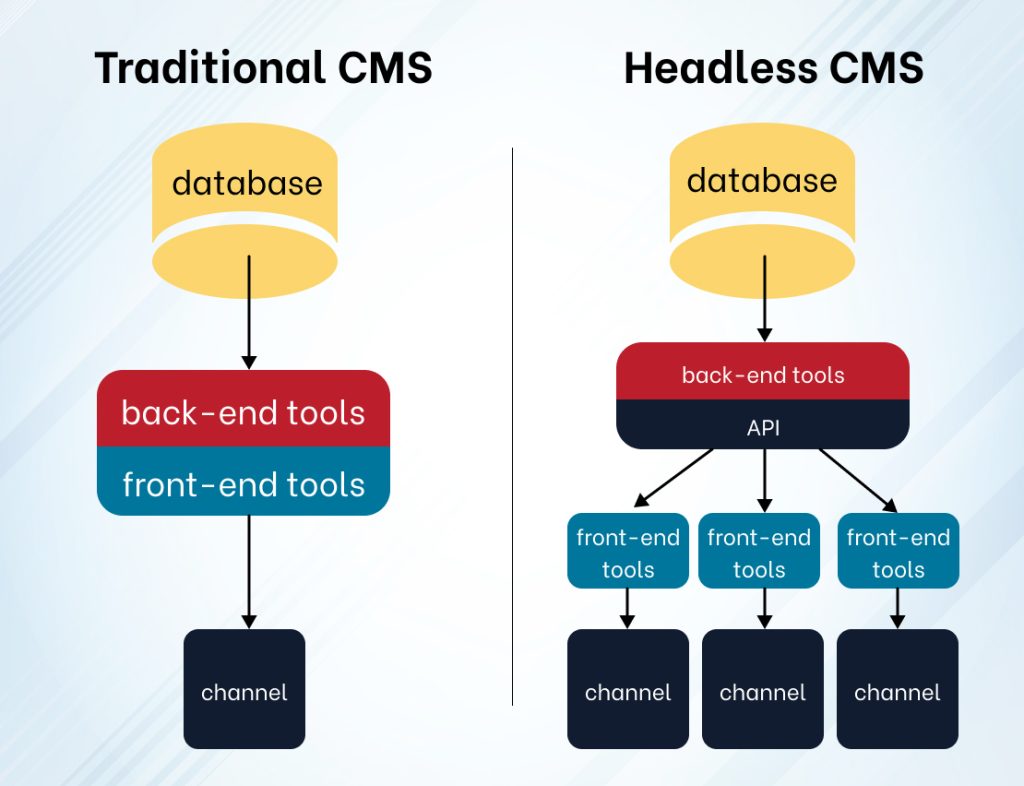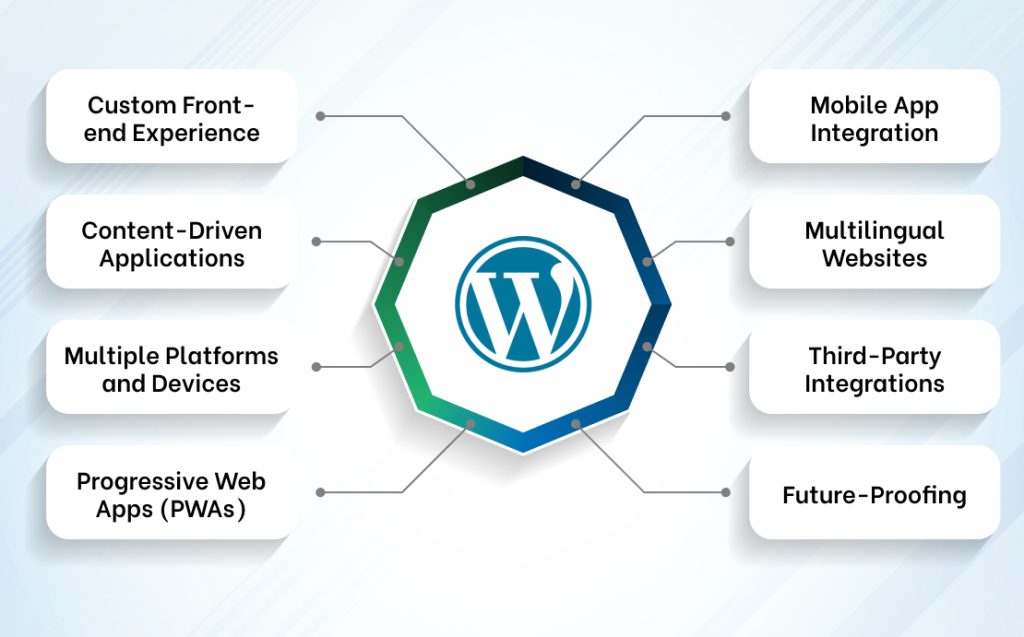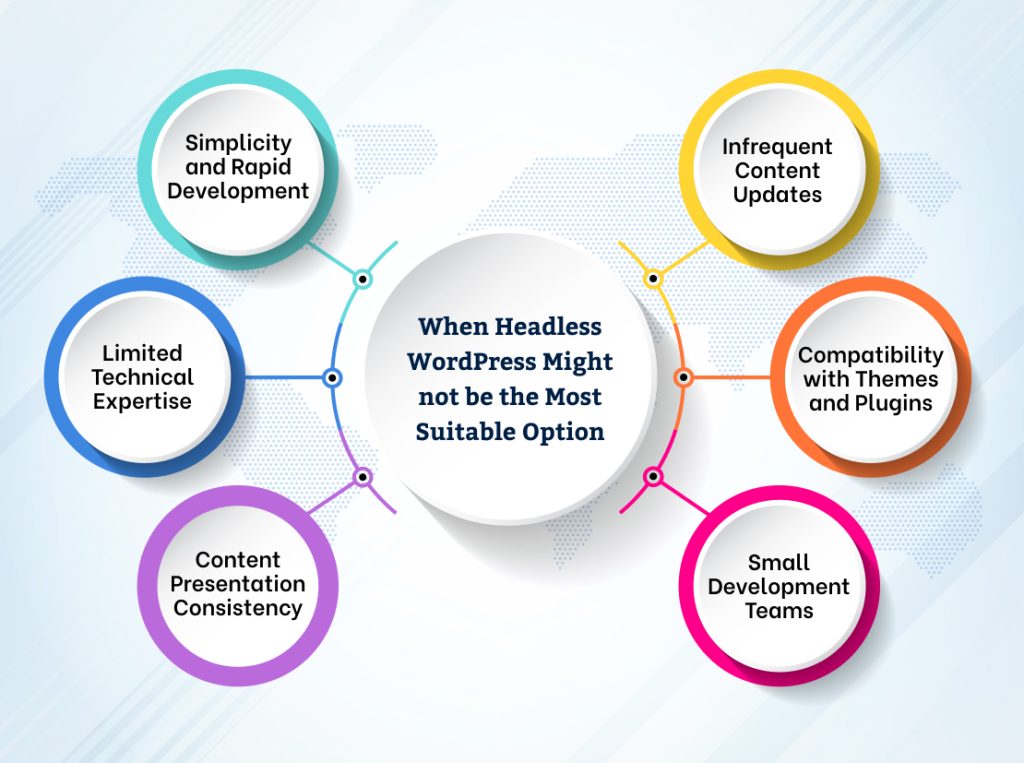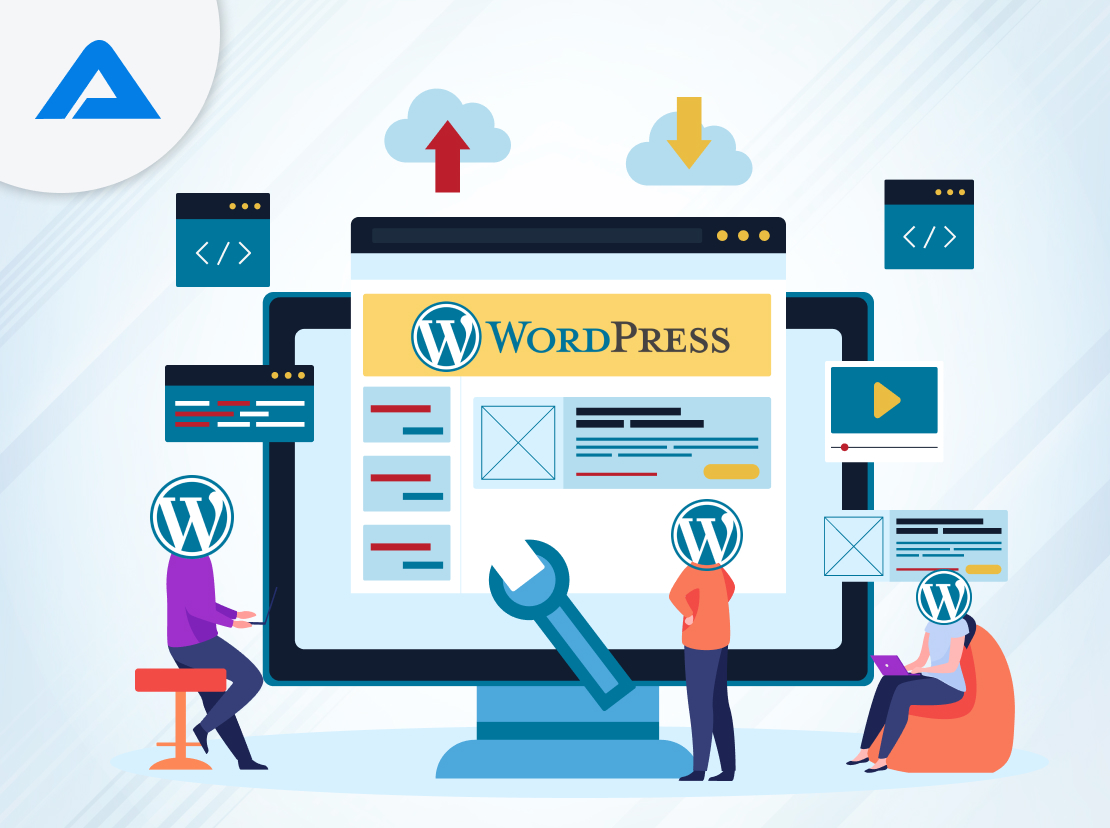WordPress is the world’s leading CMS, running over a third of websites online. It has an easy interface with extensive plugin options, but developers often are not as pleased with the traditional way it is set up. In a 7,000-developer survey conducted by the Jamstack Community, WordPress was at the bottom of the list for how well it was liked for all CMS platforms. But there’s an interesting twist; where teams are using only the content manager in Headless WordPress, the satisfaction scores rocketed.
So, why do developers prefer Headless WordPress, and what are the benefits and tradeoffs? The configuration offers the best of both worlds: marketing teams can utilize the familiar WordPress interface for content management. At the same time, developers can choose their preferred front-end technology, from a simple vanilla React site to a more sophisticated Next.js site. This setup fosters collaboration and enables each team member to excel in their respective roles.
In the following sections, we’ll delve into all the essential aspects you need to understand about headless WordPress.
Headless WordPress: A Basic Overview
Headless WordPress takes web development to the next level because of its modern and flexible approach. It separates back-end content management from front-end design, unlike traditional WordPress. This means developers can build highly customized, interactive websites and applications using powerful front-end tools like React, Angular, or Vue.js, in order to deliver dynamic digital experiences tailored to your needs.
In this architecture, WordPress serves as a robust content hub, and the front end fetches and renders the content through APIs without any issues. This is ideal for cross-platform content sharing because of its reusability. Headless WordPress also scales better and performs well since the front end is fine-tuned separately from the back end.
This basic overview of Headless WordPress opens the door for developers to explore its potential and see it as a cutting-edge option for their web development projects.
Headless WordPress vs. Traditional WordPress: A Comparative Analysis

In web development, Headless WordPress and Traditional WordPress stand as two distinct approaches, each with its own advantages and limitations. Let’s delve into a comparative analysis of these two methodologies to understand their differences and implications better.
Architectural Approaches:
Traditional WordPress: The architecture follows a monolithic design in which the back-end (content management system) and front-end (user interface) are tightly integrated into a single platform. This means that WordPress handles content creation and presentation within the same application.
The user interacts with the WordPress interface, which provides a dashboard to manage content, themes, and plugins. Themes control the website’s visual appearance, and plugins add extra functionality. The WordPress core renders the front-end templates directly, and the user’s web browser receives a fully-formed HTML document.
This architecture simplifies the development process for non-technical users and smaller projects. Content creators can easily update the website without complex coding or API interactions.
Headless WordPress: In contrast, Headless WordPress adopts a decoupled architecture, separating the back-end and front-end. The back-end continues to serve as the content management system, while the front-end is built using a different technology, often a JavaScript framework like React, Angular, or Vue.js.
In this setup, the front-end communicates with the back-end through APIs (Application Programming Interfaces). The WordPress back-end exposes content via REST API or GraphQL, and the front-end fetches this data to render the user interface.
The Headless WordPress architecture offers more flexibility for front-end development. Developers can create highly interactive and dynamic user interfaces, leveraging the latest front-end technologies while benefiting from WordPress’s robust content management capabilities.
Flexibility Analysis:
Traditional WordPress: Traditional WordPress is an all-in-one solution with tightly integrated back-end and front-end. The flexibility of Traditional WordPress lies in its extensive theme and plugin ecosystem. Thousands of themes and plugins are available, enabling users to customize the website’s look, feel, and functionality without extensive coding knowledge. This ease of customization can be a significant advantage for non-technical users or smaller projects. It allows them to set up a website with many pre-built options quickly.
However, the downside of this approach is that the flexibility could be more constrained to the available themes and plugins. Advanced customization might require deep knowledge of PHP and WordPress development, and heavily modifying existing themes or plugins can lead to compatibility issues during updates.
Headless WordPress: Headless WordPress brings unprecedented flexibility to front-end development. Developers can now use any technology they love, whether React, Angular, Vue.js, or others, to build custom, dynamic user interfaces for a seamless user experience by separating the back-end from the front-end.
This architecture is also a winner when it comes to delivering content across multiple platforms and devices using APIs. Whether it’s mobile apps, PWAs, or other cutting-edge technologies, Headless WordPress ensures your content is accessible everywhere, making it ideal for multi-channel projects.
However, while WordPress excels in front-end freedom, back-end customization could be difficult. WordPress’s core competency is in content management, so extending the functionality beyond that requires additional custom development effort.
Performance Analysis:
Traditional WordPress: With its monolithic architecture, Traditional WordPress handles content management and front-end rendering within the same application. While it offers ease of use and simplicity for content creators, it can sometimes lead to performance bottlenecks, especially on larger and more complex websites.
The main performance concerns in Traditional WordPress typically arise because the front-end templates are tightly coupled with the back-end code. This means that whenever a page is requested, the WordPress core has to process the request, query the database for content, execute PHP code, and generate the final HTML output. As a result, the response times can be slower, especially during peak traffic.
Additionally, Traditional WordPress may load unnecessary assets and scripts, impacting the website’s load times. Themes and plugins can add CSS, JavaScript, and other resources that might not be required on every page, leading to larger page sizes and longer loading times.
Headless WordPress: Headless WordPress, with its decoupled architecture, can offer better performance benefits, especially in scenarios where optimized front-end frameworks are utilized.
Since the front-end and back-end are separated, the front-end can be optimized only to request the specific content needed for each page, reducing the amount of data transfer and processing time. Modern JavaScript frameworks like React, Angular, or Vue.js allow for highly efficient rendering on the client side, resulting in faster page loads and improved user experiences.
Furthermore, the API-driven nature of Headless WordPress allows for caching strategies that can significantly enhance performance. Content can be cached at various levels, from the front-end application to CDN (Content Delivery Network) caching, reducing server load and ensuring faster content delivery.
Content Reusability:
Traditional WordPress: Content reusability is primarily limited to the website where the content is created. While it offers a user-friendly interface for content management, the content is tightly coupled with the website’s front-end templates and presentation.
For instance, if you have a blog post on a Traditional WordPress website, the content is typically accessible and visible only on that specific website. Reusing the same content on a different platform, such as a mobile app or another website, would require duplicating or manually copying it across platforms. This process can be time-consuming and inconsistent if updates are made to the original content.
Headless WordPress: Headless WordPress excels in content reusability due to its decoupled architecture and API-driven approach. Since the back-end and front-end are separated, the content can be accessed and consumed through APIs, making it easily reusable on various platforms.
With Headless WordPress, you can create a central repository of content that acts as a single source of truth. This means that blog posts, articles, images, videos, and other content types can be managed within WordPress and then fetched through APIs to display on multiple platforms, such as websites, mobile apps, PWAs, and even IoT devices. This level of content reuse streamlines the content management process and ensures consistency across different channels.
Learning Curve:
Traditional WordPress: It is widely known for its user-friendly interface and intuitive content management system. Content creators and non-technical users can quickly create and publish content without extensive training. The availability of themes and plugins simplifies website customization, making it accessible to many users.
For developers, Traditional WordPress is relatively straightforward to learn, especially if they have prior experience with PHP and web development. Many resources, tutorials, and a vast community are available to support newcomers in navigating the platform. The learning curve for customizing themes, building basic plugins, and understanding the WordPress ecosystem is generally manageable.
Headless WordPress: Headless WordPress, on the other hand, presents a steeper learning curve, particularly for non-technical users and content creators. Since the front-end and back-end are decoupled, content management happens within WordPress. Still, the display and user interface are built using separate front-end technologies like React, Angular, or Vue.js.
Content creators accustomed to the familiar WordPress interface may need help adjusting to workflow and content presentation changes. Learning how to manage content in WordPress while understanding the concepts of APIs and front-end development can require additional training and time investment.
For developers, working with Headless WordPress demands more front-end development and API integration expertise. Understanding how to fetch and render content from WordPress through APIs and building a custom front-end to display the content can be more complex than traditional PHP-based theming in WordPress.
Scaling Comparison:
Traditional WordPress: Traditional WordPress can be scalable to a certain extent, especially with proper optimization and server resources. Traditional WordPress can perform well without significant issues for smaller websites or blogs with moderate traffic.
However, as the website’s traffic and content volume grows, Traditional WordPress may need more scalability. Since the front-end and back-end are tightly integrated, the entire application needs to process each request, which can lead to performance bottlenecks during high-traffic periods.
Scaling Traditional WordPress often involves investing in powerful hosting solutions, implementing caching mechanisms, and optimizing the codebase. While these measures can improve performance, there are limits to the scalability of a monolithic architecture.
Headless WordPress: Headless WordPress offers better scalability prospects, especially for content-heavy websites and projects with varying traffic patterns. The decoupled architecture allows for better resource allocation and efficient handling of requests.
With Headless WordPress, the back-end solely focuses on content management and API delivery, reducing the load on the server. This separation of concerns enables more straightforward back-end scaling, as the server can primarily focus on serving content without the added burden of front-end rendering.
Furthermore, Headless WordPress can leverage Content Delivery Networks (CDNs) to distribute content globally and ensure faster delivery to users, regardless of location. This distributed content delivery improves performance and minimizes latency.
Related Article: A Guide to Enhance Your WordPress Site Performance
When Headless WordPress is the Most Suitable Option

Headless WordPress can be an excellent choice in several scenarios, offering specific advantages and flexibility that cater to certain project requirements. Here are some situations where using Headless WordPress makes sense:
- Custom Front-end Experience: When you need a highly customized and interactive front-end experience, Headless WordPress shines. Decoupling the back-end from the front-end allows developers to use modern JavaScript frameworks and build unique user interfaces tailored to specific project needs.
- Content-Driven Applications: Headless WordPress is ideal for content-centric projects, such as news websites, blogs, digital magazines, and e-learning platforms. It centralizes content management and enables seamless distribution through APIs across various platforms and devices.
- Multiple Platforms and Devices: If your project requires content to be delivered to multiple platforms and devices, like websites, mobile apps, smart TVs, and IoT devices, Headless WordPress excels at providing consistent content experiences across these channels.
- Progressive Web Apps (PWAs): Headless WordPress is an excellent choice for building PWAs, web applications that offer a native app-like experience on various devices. It allows you to deliver fast, engaging, offline-accessible content to users.
- Mobile App Integration: When you want to use WordPress as the content source for a mobile app, Headless WordPress provides seamless integration via APIs. Content updates in WordPress automatically reflect in the app, reducing maintenance efforts.
- Multilingual Websites: For multilingual websites, Headless WordPress offers efficient content management, simplifying translation processes and ensuring consistent content delivery across different language versions.
- Third-Party Integrations: Headless WordPress allows you to integrate easily with third-party services and tools. The decoupled architecture makes it simpler to interact with external APIs and incorporate additional functionalities.
- Future-Proofing: Adopting a Headless WordPress approach future-proofs your project by separating content management from the presentation layer. This allows you to independently upgrade or change the front-end technology without affecting the underlying content management system.
When Headless WordPress Might not be the Most Suitable Option

With its decoupled architecture, Headless WordPress provides numerous benefits for specific use cases. However, there are situations where it might not be the most suitable option:
- Simplicity and Rapid Development: A traditional WordPress installation might be more straightforward and efficient if you need to set up a website quickly without the complexities of custom front-end development. Headless WordPress can add complexity, requiring additional setup time and development efforts.
- Limited Technical Expertise: Implementing a headless architecture demands higher technical expertise, particularly in front-end development and API integration. If your team lacks the required skills or has limited resources for specialized development, a traditional WordPress approach might be more manageable.
- Content Presentation Consistency: Headless WordPress allows flexibility in front-end design, but this can lead to consistency in content presentation across different platforms and devices. Using a traditional WordPress theme might be a better option for projects where uniformity is critical.
- Infrequent Content Updates: If your website experiences infrequent content updates and dynamic features are not a priority, the added complexity of a headless setup might not justify its benefits. A traditional WordPress installation could be more than sufficient for such cases.
- Compatibility with Themes and Plugins: If your project heavily relies on existing WordPress themes and plugins, transitioning to a headless architecture may require more than that. Some themes or plugins might not be compatible with headless setups, necessitating custom development or finding alternative solutions.
- Small Development Teams: Smaller teams or individual developers may find it challenging to manage both the back and front-end separately. A traditional WordPress setup simplifies the development process by offering an integrated solution.
Related Article: WordPress Theme Customization Service
Ways to Get Started with Headless WordPress
Headless WordPress involves several steps to set up the decoupled architecture and build your custom front end. Here’s a guide to help you get started:
- Install WordPress: First, you must install and set up a WordPress instance as your content management system. You can do this by downloading WordPress from its official website and following the installation instructions provided. Alternatively, many web hosting providers offer one-click WordPress installations, making the process even more straightforward.
- Enable REST API or GraphQL: Headless WordPress relies on APIs to deliver content to the front-end. Ensure you enable either the REST API or GraphQL in your WordPress installation. Depending on your WordPress version, this can be done through plugins or custom code.
- Select Front-end Technology: Choose the front-end technology or framework you want to use for building your custom user interface. Popular choices include React, Angular, and Vue.js. Consider the project’s requirements, the team’s expertise, and the scalability of your chosen technology.
- Create API Endpoints: Determine which content you want to expose to the front end and create custom API endpoints accordingly. You can use plugins or custom development to configure these endpoints to fetch specific data from the WordPress back-end.
- Design the Front-end: Start building your custom front-end using the chosen technology. Use the API endpoints to fetch data from the WordPress back-end and display it on your user interface. You can design and style the front-end according to your project’s requirements.
- Content Management: Headless WordPress still relies on the WordPress back-end for content creation and management. Content creators can continue using the familiar WordPress interface to create and organize content, which will be consumed by the custom front end.
- Test and Optimize: Thoroughly test your custom front-end to ensure all content is fetched correctly and displayed as intended. Optimize the front end for performance and user experience, ensuring it loads quickly and functions smoothly.
- Implement Additional Features: With the flexibility of a headless architecture, you can easily integrate additional features and functionalities into your front-end. Consider integrating third-party services, e-commerce capabilities, or any other custom requirements.
- Deployment: Once your custom front-end is ready, deploy it alongside your WordPress installation. Ensure the front end can access the necessary APIs to fetch content from WordPress.
- Monitoring and Maintenance: Continuously monitor the performance of your headless WordPress setup and address any issues that arise. Regularly update the WordPress back-end and front-end to ensure security and compatibility with the latest technologies.
Conclusion
Headless WordPress is definitely a game-changing approach to development, letting developers craft dynamic user experiences that are highly customized. It separates the front-end design from the back-end content management, giving developers unmatched flexibility and the ability to easily reuse content. It’s always the perfect solution for projects where unique, content-rich and dynamic front-end designs become necessary.
To determine if Headless WordPress is the right solution, contact the expert WordPress Development Company. AddWeb Solution offers a wealth of comprehensive information to assist you in making this crucial decision. Additionally, we allow you to hire WordPress Developers for your upcoming project. Our skilled developers stay up-to-date with the latest technologies and trends, ensuring you receive top-notch, cutting-edge solutions tailored to your business needs.
Understanding the fundamentals of Headless WordPress allows developers to make informed decisions about adopting this approach. By leveraging its strengths and mitigating its challenges, teams can harness the full potential of Headless WordPress to build exceptional digital experiences and stay ahead in the ever-evolving world of web development.

